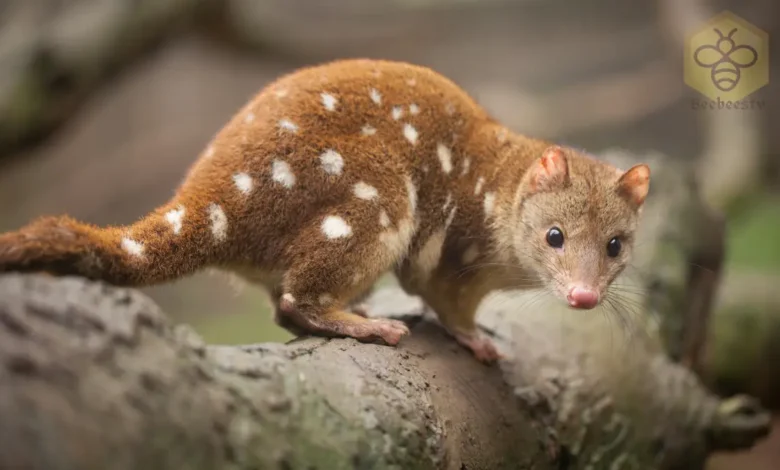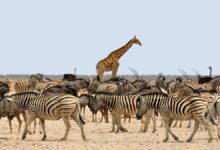Quolls: Habitat, Diet, Reproduction, Size, and more…

The Quoll: A Unique Marsupial of Australia and New Guinea
Quolls
Introduction
The quoll, a small carnivorous marsupial native to Australia, New Guinea, and Tasmania, is one of the most fascinating yet lesser-known animals. With its distinctive spotted coat, sharp predatory skills, and important role in the ecosystem, the quoll plays a vital part in maintaining the balance of its environment.
Scientific Name
The scientific name of the quoll depends on the species, with six recognized species belonging to the genus Dasyurus.
Common Name
The common name of this animal is “quoll.” Historically, it was also called the “native cat” due to its resemblance to small predatory felines, though it is not related to cats.
Scientific Classification
| Kingdom | Animalia |
| Phylum | Chordata |
| Class | Mammalia |
| Order | Dasyuromorphia |
| Family | Dasyuridae |
| Genus | Dasyurus |
Types of Quolls
There are six species of quolls:
- Eastern Quoll (Dasyurus viverrinus): Found in Tasmania.
- Northern Quoll (Dasyurus hallucatus): Native to northern Australia.
- Tiger Quoll (Dasyurus maculatus): The largest quoll species, found in eastern Australia.
- Western Quoll (Dasyurus geoffroii): Endemic to southwestern Australia.
- Bronze Quoll (Dasyurus spartacus): Found in New Guinea.
- New Guinean Quoll (Dasyurus albopunctatus): Native to New Guinea.
Habitat
Quolls are adaptable and inhabit a range of environments depending on the species. They are found in:
- Forests: Rainforests and eucalyptus woodlands are prime habitats for quolls.
- Grasslands: Some species, like the northern quoll, inhabit savannahs and grasslands.
- Mountains: They also live in mountainous areas with dense vegetation.
- Deserts: The western quoll, for instance, occupies more arid regions of Australia.
Quolls are nocturnal animals, meaning they are most active at night. They build dens in hollow trees, rocky crevices, or burrows to hide during the day.
Physical Characteristics
Quolls are small to medium-sized marsupials with the following characteristics:
- Size: Depending on the species, quolls can range in size from 11 to 30 inches (28 to 75 cm) in length, with tails adding an additional 10 to 20 inches (25 to 50 cm).
- Weight: They typically weigh between 2 to 15 pounds (1 to 7 kg), with the tiger quoll being the largest species.
- Fur: They have soft, thick fur that is usually brown or black, with distinctive white spots covering their bodies.
- Face and Limbs: They have sharp claws, strong jaws, and a pointed snout, all of which aid in hunting and climbing.
Diet
Quolls are carnivores, and their diet mainly consists of small animals. As apex predators in their ecosystems, they play a crucial role in controlling prey populations.
- Favorite Prey: Quolls hunt a variety of small mammals, birds, reptiles, and insects. They are known to eat possums, birds, frogs, and even carrion.
- Hunting Behavior: They are ambush predators, using stealth and patience to capture their prey. Their sharp teeth and strong jaws allow them to tackle prey larger than themselves.
Predators and Threats
Despite being skilled hunters, quolls face numerous threats from both natural predators and human activities.
- Natural Predators: Large birds of prey, snakes, and dingoes are natural predators of quolls, particularly young or inexperienced individuals.
- Human-Induced Threats: Habitat destruction, land clearing for agriculture, and urban development are major threats to quoll populations. The introduction of non-native species like foxes, feral cats, and dogs has also contributed to quoll decline. Ingesting cane toads, which are toxic to quolls, is a significant threat, particularly to the northern quoll.

Reproduction, Babies, and Lifespan
Quolls have a short breeding season, usually between April and July, depending on the species.
- Mating Behavior: Female quolls go into heat once a year and mate with multiple males during this period. Mating can be quite aggressive, with males sometimes injuring females during the process.
- Gestation and Babies: After a short gestation period of around 21 days, female quolls give birth to up to 18 tiny, underdeveloped young. However, only about six to eight young will survive due to the limited number of teats available.
- Weaning and Independence: The young remain attached to their mother’s pouch for about eight weeks, after which they are weaned and begin exploring outside the den. By five to six months of age, they are independent.
- Lifespan: In the wild, quolls live between two to five years, with some individuals reaching up to seven years in captivity.
Population
Quoll populations have dramatically declined over the past century due to habitat destruction and predation by introduced species. While some populations are stable, others, like the northern and western quolls, are endangered or vulnerable. Conservation efforts, including habitat restoration and predator control programs, are ongoing to protect these species.
Behavior and Lifestyle
Quolls are solitary creatures, with each individual maintaining its territory. They are nocturnal and spend the majority of the day sleeping in dens. They are excellent climbers and can hunt both on the ground and in trees. Males typically have larger territories than females, and they are highly territorial, often marking their range with scent to ward off intruders.
Ecological Role
As carnivorous marsupials, quolls play an essential role in maintaining the balance of ecosystems. By preying on small mammals, birds, and insects, they help control pest populations. They are also scavengers, consuming carrion and contributing to the natural recycling of nutrients within their habitat.
FAQs About Quoll
- What is a quoll?
A quoll is a small to medium-sized carnivorous marsupial native to Australia, New Guinea, and Tasmania. It is known for its spotted coat and sharp predatory skills. - Where do quolls live?
They inhabit forests, grasslands, mountainous areas, and arid regions in Australia and New Guinea. They build dens in hollow logs, trees, or burrows. - What do quolls eat?
They are carnivores, feeding on small mammals, birds, reptiles, insects, and carrion. They are ambush predators with sharp claws and strong jaws. - How long do quolls live?
In the wild, They live for two to five years, with some individuals reaching seven years in captivity. - Are quolls endangered?
Several quoll species are listed as endangered or vulnerable due to habitat loss, predation by introduced species, and poisoning from cane toads.
Conclusion
The quoll is a remarkable marsupial that plays a crucial role in its ecosystem as a top predator and scavenger. While some species of quolls are relatively stable, others are facing severe threats due to human activities and invasive species. Conservation efforts are essential to ensuring the survival of this unique animal and preserving the biodiversity of its natural habitat. Protecting quolls is not only crucial for the species but also for the balance of the ecosystems they help sustain.


